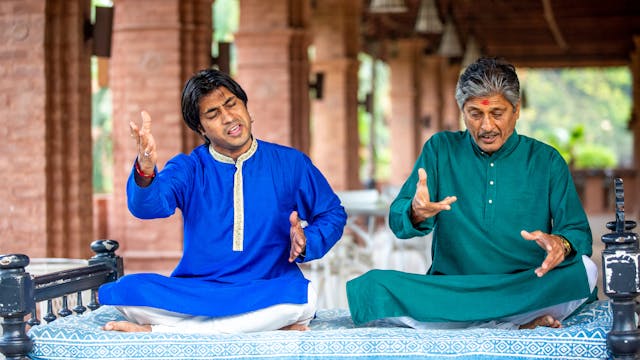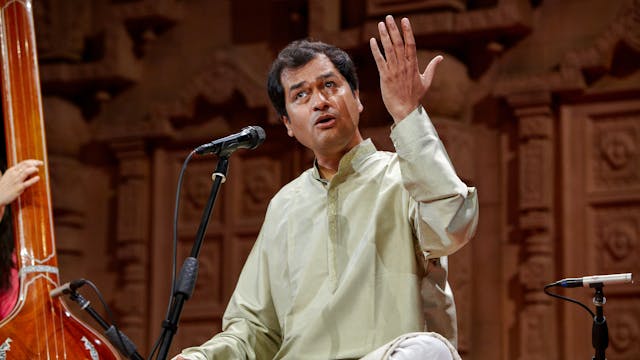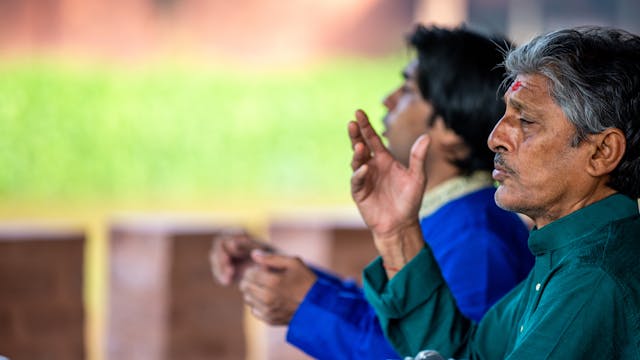Prem Kumar Mallick | Raag Bhimpalasi
Dhrupad
•
15m
Recorded at Darbar Festival 2007, at the Phoenix Theatre, Leicester.
Musicians:
- Pandit Prem Kumar Mallick (Darbanga dhrupad)
- Prashant Mallick (Darbanga dhrupad)
- Ravishankar Upadhyay (pakhawaj)
- Debipriya Das & Gunwant Dhadyalla (Tanpuras)
Raag Bhimpalasi, Thaat: Kafi, Samay: Afternoon
Pandit Prem Kumar Mallick and his son Prashant Mallick are a gifted father and son duo. Their commitment to dhrupad comes as a force visible in their stunning performances. They sing a traditional bandish from the Darbhanga gharana in Raag Bhimpalasi in this recital set to Dhamar taal.
After a brief alap they begin the bandish, doling out an immersive experience of swaras and rhythm for their audiences. The lyrics of the composition depict the playful interaction between Lord Krishna and his consort Radha during Holi, the festival of colours in India that is played to welcome the season of spring.
Pandit Mallick leads, immortalising the beautiful blend of melody and laykari of Darbhanga in his deep, raspy voice. He traverses the lower-most and upper-most octaves with ease, paving way for Prashant Mallick to elaborate further in total tunefulness and wit.
They deploy stunning laykari, stretching and tweaking the lyrics of the bandish on a double, teesra jati (three-fold), pancham (five-fold) and khanda jati (seven-fold) rhythmic transposition over the 14-beat cycle with the charming accompaniment of Ravi Shankar Upadhyay on the pakhawaj.
An oft-heard compound raga churned out of Bhim and Palasi, Raag Bhimpalasi has overshadowed both its Janak (parent) ragas. It belongs to Kafi Thaat and its jati is audav-sampoorna, that is, it uses five notes in its ascent and all seven notes in its decsent. The dominant note or vadi swar is Ma (4th) and the sub-dominant or samvadi swar is Sa (1st). This raga omits Re (2nd) and Dha (6th) in its ascent and sports komal Ga (flat 3rd) and komal Ni (flat 7th). The arohana and avarohana are structured as follows:
n. S g M P n S’ (Western Notes: A# C D# F G A# C)
S’ n D P M g, M g R S (Western Notes: C A# A G F D#, F D# D C)
Mythically Krishna, the cowherd boy, played this sweet melody on his flute to give a return call to all his grazing cows and cowherd friends. As such this raga, exuding peace and assurance, is associated with homecoming and offers a vast canvas for improvisations. Its universal appeal has made it very popular in every genre of Indian music; so much so that Bhim and Palasi are almost extinct now. Bhimpalasi is also adopted by Carnatic stream as Bhimpalas.
Up Next in Dhrupad
-
Ram Kumar and Samit Mallick | Bhoop K...
Filmed and recorded live at Bawali Rajbari, Kolkata, in 2017.
Musicians
- Ram Kumar Mallick (vocal)
- Samit Mallick (vocal)Raag Bhoop Kalyan, Thaat: Kalyan, Samay: Evening
Raag Bhoop Kalyan is also known as Shuddh Kalyan. Its ascending notes have the same notes as Raag Bhopali and its descen...
-
Uday Bhawalkar | Raag Bhimpalasi
Recorded at Darbar Festival 2011, on 24th April, at King's Place, London.
Musicians:
- Uday Bhawalkar (dhrupad)
- Sukhvinder Singh ‘Pinky’ (jori)
- Ranjana Ghatak & Gunwant Dhadyalla (tanpura)Raag Bhimpalasi; Thaat: Kafi; Samay: Afternoon
Bhawalkar belongs to a handful of dhrupad singers w...
-
Pandit Ram Kumar and Samit Mallick | ...
Recorded for Darbar Festival in 2016, on location in Kolkata, West Bengal, India.
Musicians:
- Ram Kumar Mallick (dhrupad vocal)
- Samit Mallick (dhrupad vocal)Raag Bhimpalasi; Thaat: Kafi; Samay: Afternoon
It is said that the ancestors of the Mallick family, Darbhanga court musicians, once e...



